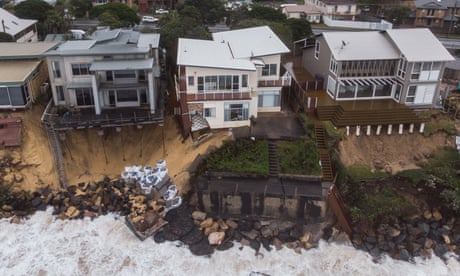- by foxnews
- 08 Apr 2025
Australia faces worsening extreme weather events latest BoM and CSIRO climate report finds
Australia faces worsening extreme weather events latest BoM and CSIRO climate report finds
- by theguardian
- 23 Nov 2022
- in news

The continent is now 1.47C hotter than it was in 1910 and sea levels around the coastline are rising at an accelerating rate, according to the 2022 State of the Climate report, a series released every second year.
Many of the changes are being driven by rising levels of greenhouse gases in the atmosphere caused mostly by the burning of fossil fuels.
The report, published by the Bureau of Meteorology and CSIRO, provides a snapshot of changes on land and ocean, including temperature, rainfall, storms and droughts.
The Albanese government took to the summit an improved emissions target of 43% by 2030, based on 2005 levels, but independent analysis says the commitment is not in line with keeping global heating to 1.5C.
On Tuesday evening, the government announced it was adding $500m to the Clean Energy Finance Corporation to commercialise renewable energy, improve energy efficiency and develop other clean energy technologies.
The State of the Climate report shows day and night-time temperatures in Australia are rising, as is the number of extremely hot days in all months.
As an example, the report says there were 33 days in 2019 when the national average maximum temperature went above 39C. This was more days in one year than in all the previous 58 years.
Blair Trewin, a senior research scientist at the bureau, said there was a consistent increase of about 10% in the maximum hourly rainfall rates over the past few decades.
In alpine regions, there is a trend to shallower snow over a reduced area and for a shorter period.
The report finds marine life is experiencing longer and more frequent heatwaves and oceans are acidifying about 10 times faster than at any time over the past 300m years. The acidification is caused by the extra CO2 in the air above.
As the oceans heat up, sea levels are rising around the continent at an annual rate of 2-3mm in most places and as much as 7-8mm in the Gulf of Carpentaria and the waters around Sydney.
Several glaciers in the west of Antarctica are destabilised, the report says, and glaciers and ice sheets around the world are melting, further adding to sea levels.
The report says most of the current trends are set to get worse, with more heat, higher sea levels, longer droughts and more intense rainfall events.
There could be fewer cyclones, but a higher proportion of those that do form are likely to be larger and more damaging.
Husic said the report reinforced the urgent need for action.
A seperate system in the Indian Ocean that has also been pushing more rain across the south of the continent is likely to dissipate in the next two weeks.
- by foxnews
- descember 09, 2016
Ancient settlement reveals remains of 1,800-year-old dog, baffling experts: 'Preserved quite well'
Archaeologists have recently unearthed the remarkably well-preserved remains of a dog from ancient Rome, shedding light on the widespread practice of ritual sacrifice in antiquity.
read more


